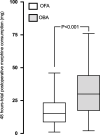Feasibility and postoperative opioid sparing effect of an opioid-free anaesthesia in adult cardiac surgery: a retrospective study
- PMID: 34082712
- PMCID: PMC8173983
- DOI: 10.1186/s12871-021-01362-1
Feasibility and postoperative opioid sparing effect of an opioid-free anaesthesia in adult cardiac surgery: a retrospective study
Abstract
Background: No previous study investigated the dexmedetomidine-based opioid-free anesthesia (OFA) protocol in cardiac surgery. The main objective of this study was to evaluate the feasibility and the postoperative opioid-sparing effect of dexmedetomidine-based OFA in adult cardiac surgery patients.
Methods: We conducted a single-centre and retrospective study including 80 patients above 18 years old who underwent on-pump cardiac surgery between November 2018 and February 2020. Patients were divided into two groups: OFA (lidocaine, ketamine, dexmedetomidine, MgSO4) or opioid-based anaesthesia (remifentanil and anti-hyperalgesic medications such as ketamine and/or MgSO4 and/or lidocaine at the discretion of the anesthesiologist). The primary endpoint was the total amount of opioid consumed in its equivalent of intravenous morphine during the first 48 postoperative hours. Secondary outcomes included perioperative hemodynamics, post-operative maximal pain at rest and during coughing and adverse outcomes. Data are expressed as median [interquartile range].
Results: Patients in the OFA-group had a higher EuroSCORE II, with more diabetes, more dyslipidemia and more non-elective surgery but fewer smoking history. In the OFA group, the median loading dose of dexmedetomidine was 0.6 [0.4-0.6] μg.kg- 1 while the median maintenance dose was 0.11 μg.kg- 1.h- 1 [0.05-0.20]. In 10 (25%) patients, dexmedetomidine was discontinued for a drop of mean arterial pressure below 55 mmHg. The median total amount of opioid consumed in its equivalent of intravenous morphine during the first 48 postoperative hours was lower in the OFA group (15.0 mg [8.5-23.5] versus 30.0 mg [17.3-44.3], p < 0.001). While no differences were seen with rest pain (2.0 [0.0-3.0] versus 0.5 [0.0-5.0], p = 0.60), the maximal pain score during coughing was lower in OFA group (3.5 [2.0-5.0] versus 5.5 [3.0-7.0], p = 0.04). In OFA group the incidence of atrial fibrillation (18% versus 40%, p = 0.03) and non-invasive ventilation use (25% versus 48%, p = 0.04) were lower. The incidence of bradycardia and the intraoperative use of norepinephrine were similar between both groups.
Conclusion: Dexmedetomidine-based OFA in cardiac surgery patients is feasible and could be associated with a lower postoperative morphine consumption and better postoperative outcomes. Further randomized studies are required to confirm these promising results and determine the optimal associations, dosages, and infusion protocols during cardiac surgery.
Keywords: Cardiac surgery; Dexmedetomidine; Morphine; Opioid-free anaesthesia; Pain.
Conflict of interest statement
The authors declare that they have no competing interests.
Figures
References
-
- Cheng DC, Newman MF, Duke P, Wong DT, Finegan B, Howie M, Fitch J, Bowdle TA, Hogue C, Hillel Z, Pierce E, Bukenya D. The efficacy and resource utilization of remifentanil and fentanyl in fast-track coronary artery bypass graft surgery: a prospective randomized, double-blinded controlled, multi-center trial. Anesth Analg. 2001;92(5):1094–1102. doi: 10.1097/00000539-200105000-00004. - DOI - PubMed
Publication types
MeSH terms
Substances
LinkOut - more resources
Full Text Sources
Medical


